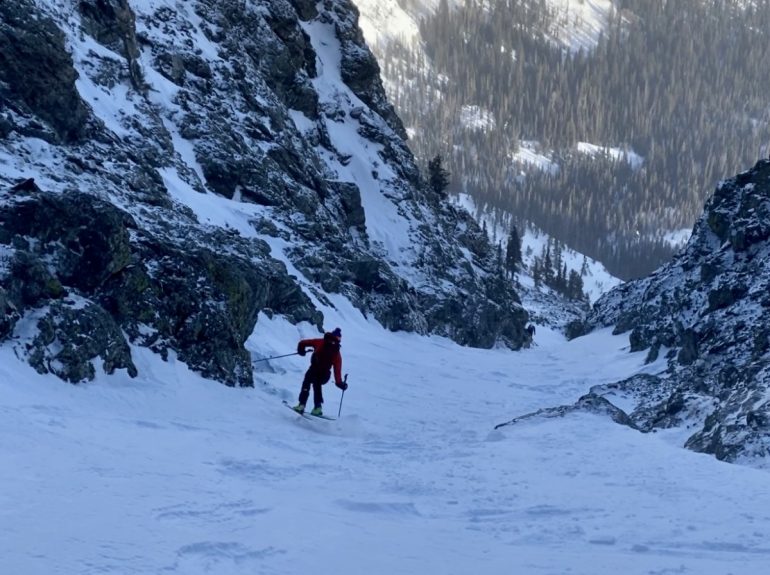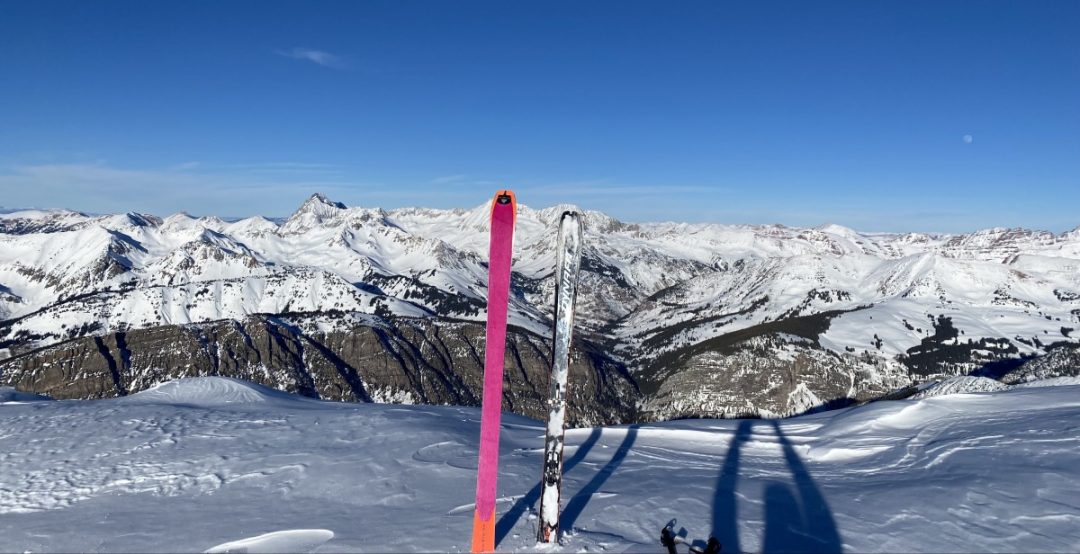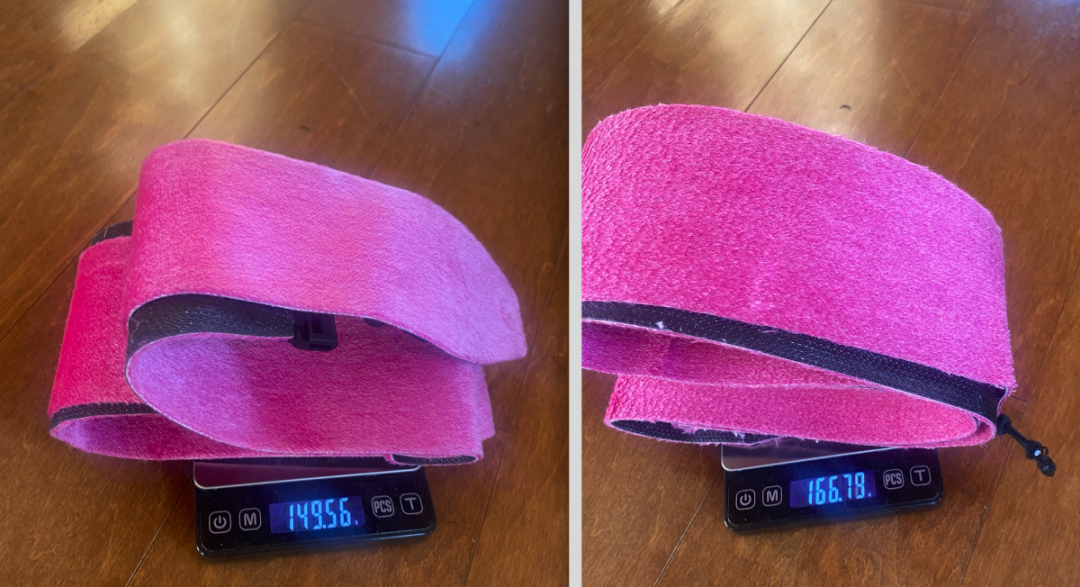
In their element: couloir jump turning on the Blacklight Pro.
Although some of the meaning of the oxymoronic name of “Blacklight” seemed to be lost in translation, during my first look at the ski two years ago, that Dynafit ski line spoke to me. Afterall, 90% of the ski missions I attempt begin in the predawn hours of scattered starlight.
Dynafit covers the range of widths one might consider when choosing a ski mountaineering board for deep objectives. The Blacklight series comes in the following configurations:
- Blacklight 74
- Blacklight 80
- Blacklight 88
- Blacklight Pro
- and the newest Blacklight 95
 Dynafit’s Blacklight Pro.
Dynafit’s Blacklight Pro.
Since my initial review, I was lucky enough to get on the newly released 95mm underfoot version, giving the series a ski mountaineering option that can also easily handle powder. However, my desire for efficiency causes me to gravitate to skis with less mass. Enter the Dynafit Blacklight Pro, a thousand-gram ski at the pinnacle of the series.
For years the Dynafit DNA was my go-to race ski. I’m continually astounded by the DNA’s durability in this typically fragile quiver slot. So when I heard that Dynafit took the race construction and widened it to 81 underfoot, I was eager to test it. Made with two sheets of carbon under a thin topsheet, I can only describe the ski as stiff. This rigidity translates to excellent edge hold when your balance is perfect but can be a bit of a chattery ride when I’m thrown out of rhythm. The skis are undeniably light at 980 grams in my test length of 172, and in my 10 months of skiing them, I put them through various conditions.
Many different reasons and objectives draw me uphill when traveling on skis. Sometimes, I search for slow days, enjoying views and the company of ski partners, giving way to the soulful shush of downhill days. Then there are crisp cold mornings when I want to taste iron for the coveted hour and a half I have before the workday begins. The latter is the reason for the Blacklight Pro. As the early season hamster wheel of resort uphill training gives way to a growing backcountry snowpack and the call of my wildly inefficient powder skis, I couldn’t wait to take the Blacklight Pros to the local track.

Out and about with the Blacklight Pros and pink Pin-Skins.
I took the skis to my favorite skin track, aware of the fast time to the top, to see what I could shave off with this light and efficient setup. However, the conditions that day were not on my side. Sun had baked the path, and previously struggling skinners had blown out the switchbacks. Yet, I struggled as much as anyone on each icy kickturn. Was it the three quarters length skin, the snow conditions, or just the fact that I was trying to go too fast? About halfway up, I decided it wasn’t my day, and I settled into pulling my shit-show together in favor of going back to the basics of weighting my heels and gliding forward with proper technique.
It is always easier to blame backsliding on skiers that came before, pushing the track to a steepness that seems to defy physics. It is even easier to blame your skins, and at first, I believed there were many limitations in the new Pin-Skin design and construction. Although they are the same empowering pink color as my Pomoca race skins, they felt far slower uphill. This particular pink is Pomoca’s Pro Grip, a 70/30 blend of mohair and nylon, while their classic race skin is 100% paper-thin mohair. The Pin-Skin is treated with the same race glide formula, and after a handful of days, they broke in to be less sticky while gliding forward, and I grew to appreciate them.
The pin system seems to be another partial miss on the tail fixation when you first go to rip. After grabbing the rubber speed tip, pioneered by Dynafit for the last 20 odd years, the skin was easy to tear away, but the tail hung up badly on the pin attachment. The first 10 times I used the skin, I surrendered to just removing my skis for downhill transitions. However, with some practice and extra one-legged balance, I developed a rip and shake method that eventually wiggles the pin out of its home. I’m back to executing the transition without ski removal.

A side by side view of the Pin-Skins (left in both images), and straight up pink race skins (right in both images).
On the positive side, the shorter skin and the hard-to-remove pin make it nearly impossible for these skins to ever fall off your ski even in the iciest conditions. For comparison, I cut a pair of skins off an 85mm Pomoca race roll. Leaving them full length so I could install a tail clip at another time, I did some A/B testing. The Pin-Skin gets the edge for being slightly lighter weight, but I wondered if the full tail coverage of the race roll would increase grip, while the race plush would increase glide. Going out for a long day of 10,000 vertical feet of skinning on different aspects and steepness of track and a wide variety of temperature gradients, I couldn’t find an edge one way or another on skin performance. However, after the 5th transition and the steepest skin track of the day, the tailless race skins failed while the Pin-Skins kept going strong.

Skin weight comparison: Pin-Skin on the left, full length race skin right.
Back to my speed test on the skintrack: I was surprised that I had shaved 10% off my fastest time, even with my floundering far below. But now it was time to ski the skinny sticks in tracked chunky and faceted powder. The tips flaring to 116 mm in width and reminiscent of the “scoop rocker” on my coveted, ancient, and mostly destroyed Dynafit Cho Oyu skis, won the battle against the stiff and unforgiving tails; I thoroughly enjoyed the ride. I made classically short hoppy powder turns, reducing the radius to match the skinniness of the skis from what my imagined arcing freeride powder turns would have been on wider boards. However, in the past week of bottomless skiing, I got out in turn on both the Black Crows Navis Freebird (102 mm underfoot) and the iconic DPS Pagoda Tour (112 mm underfoot), and no freeride skier did they make. The meager 81 mm waste of the Blacklight Pro proves an ample platform for soft and what I believe to be the most forgiving snow conditions.
Later in the spring, in my all too short spring season, I tried them in closer to their intended conditions of variable ski mountaineering. The ski aggressively holds an edge at fast speeds in good spring conditions, but they are quite stiff. This rigidity would translate into a good amount of chatter if I was off balance going into an icy turn. I had originally mounted the Blacklight Pros with the Dynafit Superlite 150 binding with no adjustment plate for my Scarpa Alien 1.0 boot. Between the unforgiving flex of the carbon cuff of the Alien and the race carbon in the skis, it proved to be more than I could handle in variable conditions.
After adding the adjustable track, I skied them with my Scarpa F1 LT boots and found a great middle-ground for weight versus performance. With the bigger boot, the setup quickly became my go-to for technical spring skiing, and I could easily flip the skis quickly for jump turns, and edge on hard steep snow.
With a bit of balance and grace that I find elusive in my skiing style, the Blacklight Pros offer maximum efficiency of mountain motion and a fun ski down. These boards are not for the faint of heart as, like many skis in this quiver spot, they are stiff, sharp, and straight. But when I am looking for a set of precision skis to clean up my less than precise ski technique, I will reach for these for years to come.

A sneak peak of the Blacklight ski boot. More coming soon.
As a gear teaser, I was lucky enough to get to test the entire blacklight kit together. On top of the ski and pin system, this consisted of carbon fixed length poles, ultralight 30-liter pack, and the new and never seen Dynafit Blacklight Boot. A review of the entire kit working in concert is coming soon!
Blacklight Pro Specs:
Dimensions (172cm): 116-80-100
Weight: 960g (172cm)
Radius: 17m (172cm)
Construction: Paulownia Race Core/Race Carbon
MSRP: $799.95
Shop for the Dynafit Blacklight Pro
Doug Stenclik is an avid skimo racer and ski mountaineer who lives for sharing the amazing sports of ski touring and splitboarding. Since his first time on skins he was hooked and the obsession has taken him all over the United States and the world pursuing the human powered ski turn. He founded Cripple Creek Backcountry in 2012 and took over the Colorado Ski Mountaineering Race Cup in 2014 to spread knowledge and the love of the sport. In 2019 he took a step back from the ski shop and race promoter life to become a publishing partner with WildSnow.
